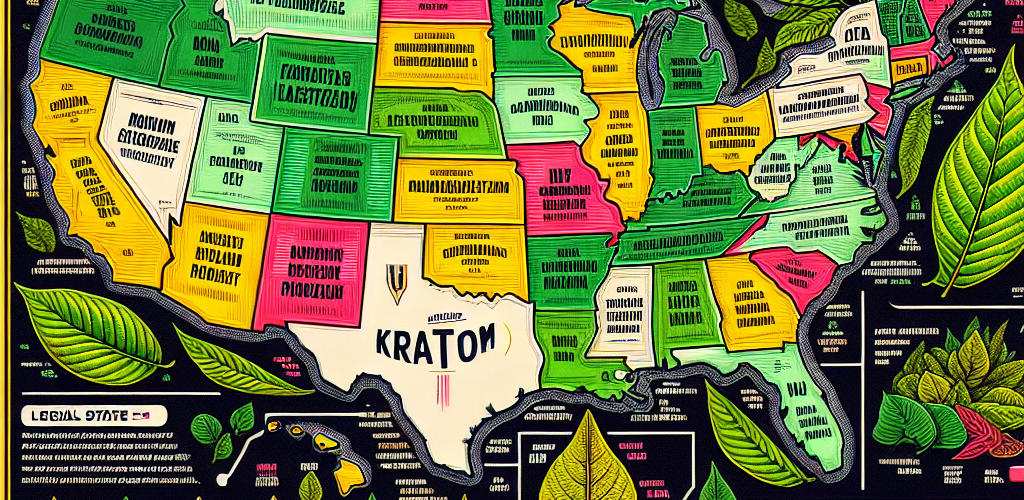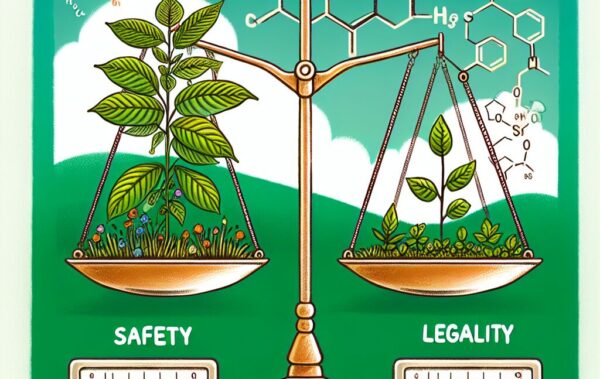- Overview of Kratom and its uses
- Federal classification of Kratom
- State-by-state Kratom regulations
- Factors influencing Kratom’s legal status
- Frequently Asked Questions about Kratom
Kratom, a plant native to Southeast Asia, has garnered significant attention due to its intriguing dualistic nature. It belongs to the Mitragyna speciosa species and is regarded for its unique potential both as a stimulant and as a sedative, depending on the dosage consumed. On one hand, in lower doses, it is known for providing a boost of energy and increased focus, attributes that have made it particularly popular among individuals facing rigorous demands in their daily routines. On the other hand, higher doses of kratom are frequently sought out for their sedative effects, which can contribute to pain relief and a calming sensation, thus aiding those with sleep disorders or chronic pain issues.
The plant’s leaves contain compounds known as alkaloids, with mitragynine and 7-hydroxymitragynine being the most prominent. These compounds interact with opioid receptors in the brain, which can lead to pain relief and other opioid-like effects, although kratom is not classified as an opioid itself. Due to this attribute, the leaves are often crushed or powdered and ingested in various forms such as kratom powder, capsules, or brewed into tea. Kratom can also be found in more potent forms such as extracts and concentrates.
Originally used by manual laborers in Southeast Asia to withstand long hours of physical toil, kratom has traversed geographical borders and is now utilized for various reasons globally. People may use kratom to manage withdrawal symptoms from opioids or to potentially reduce dependence on these substances, although scientific evidence regarding this application is still evolving. Furthermore, for those seeking alternative ways to cope with anxiety or mood disorders, kratom is sometimes explored as a potential herbal remedy.
However, the buzz surrounding kratom isn’t solely focused on its uses. There’s also significant conversation around its “Kratom Classification”, “State Restrictions”, “Legal Status”, and “Kratom Laws”. Different authorities, from the federal to state levels, grapple with how to regulate this plant, given the divergent views on its safety, efficacy, and potential for misuse. What makes the conversation particularly complex is that kratom may be seen as a beneficial botanical supplement by some, while others view it as a potentially dangerous substance warranting strict control. This dichotomy underscores the debate surrounding this multifaceted plant and sets the stage for further exploration into both its potential benefits and risks.
Federal classification of Kratom
Amidst the ongoing conversation surrounding the complex nature of kratom is the challenge presented by its federal classification in the United States. Kratom classification is a contentious topic that has led to debates among regulators, lawmakers, healthcare professionals, and consumer advocates. At the federal level, kratom is not currently classified as a controlled substance by the United States Drug Enforcement Administration (DEA). However, this does not mean it has fully received a clean bill of legal health.
In 2016, the DEA announced its intention to classify kratom as a Schedule I substance, which would put it in the same category as heroin, LSD, and ecstasy, indicating a high potential for abuse and no accepted medical use. The proposed emergency scheduling was met with public backlash, including petitions, protests, and calls from Congress to reconsider the decision. In response to this reaction, the DEA withdrew the proposal and opened a period for public comment. As of the last update to this situation, the DEA has not moved forward with scheduling kratom, and it remains unscheduled at the federal level.
The U.S. Food and Drug Administration (FDA), on the other hand, has taken a firmer stance against kratom. The FDA has issued numerous warnings concerning the safety and efficacy of kratom, emphasizing concerns over its potential for abuse, addiction, and serious health risks, including death. The agency claims that kratom affects the same opioid brain receptors as morphine and appears to have properties that expose users to the risks of addiction, abuse, and dependence. Despite these warnings, the FDA does not have the authority to ban kratom outright; this power rests with the DEA.
Though not federally classified as illegal, kratom’s legality is in a state of flux, with regulatory standing varying from state to state. It falls into a regulatory grey area, where it’s neither fully endorsed as a dietary supplement nor is it approved for medical use. As such, distributors typically offer kratom as a botanical product “not for human consumption,” although such disclaimers are not always a safeguard against federal action.
Because the FDA does not approve kratom for any medical use, it also does not specify guidelines for safe dosages, which leaves users and proponents of kratom in a precarious situation. Advocates argue that a lack of clear, federally-endorsed guidelines could potentially lead to unsafe use and bolster the argument for prohibition, while careful regulation could mitigate these risks.
For those interested in the various kratom products available, it may be valuable to explore different forms and strains, such as Maeng Da kratom powder or Sumatra kratom capsules, while remaining consciously informed about the evolving legal landscape and adhering to state laws where applicable.
In essence, at the federal level, “Kratom Classification” and “Kratom Laws” remain under a cloud of uncertainty. There is no nationwide ban on kratom, but there is also no widespread endorsement, leading to a disjointed legal landscape that continues to evolve. Consequently, interested parties are encouraged to stay abreast of not only federal developments but also the “State Restrictions” and “Legal Status” on a local level, which we will discuss in the following sections.
State-by-state Kratom regulations
When examining “Kratom Classification” and “State Restrictions,” it’s essential to navigate the intricate patchwork of regulations that govern its use across America. Unlike federal agencies, states have the authority to establish their own “Kratom Laws” and determine the “Legal Status” of the plant within their borders. This variability can cause confusion for consumers, retailers, and law enforcement alike, as what’s permissible in one state might be illegal in another.
As of now, several states have enacted their own laws regarding kratom. These range from complete bans to age restrictions and labeling regulations. For instance, some states have signed the Kratom Consumer Protection Act, which mandates standards for kratom sales, including lab testing and proper labeling to ensure safety for consumers. The act aims to prevent adulteration and contamination of kratom products, which can pose serious health risks.
It’s important for kratom enthusiasts and vendors to be well-informed about the current “State Restrictions” to abide by the law. For those dealing with specific forms of kratom, such as kratom shots or Borneo kratom powder, an understanding of both local and state regulations is crucial given the varying degrees of legality.
To illustrate the varying degrees of regulation across the states, consider the following:
- States where kratom is banned: Several states, including Alabama, Arkansas, Indiana, Rhode Island, Vermont, and Wisconsin, have classified kratom as a controlled substance, making its sale and possession illegal within state lines.
- States with age restrictions: Some states permit the sale of kratom but restrict its purchase to individuals over a certain age, often 18 or 21.
- States requiring regulation and compliance: States like Utah, Georgia, and Nevada have passed the Kratom Consumer Protection Act, which sets guidelines for purity and labeling requirements for kratom products.
- States with pending legislation: Other states have ongoing discussions about kratom, with proposed bills and pending legislation that could either restrict, ban, or protect consumer usage of kratom.
In states where kratom remains legal, consumers continue to have access to various kratom products, from the powerful kratom tinctures and extracts to more traditional forms like powders and capsules.
Regardless of state law, it is advisable for consumers and retailers to exercise due diligence when partaking in the kratom market. Compliance with regulation is not only a legal necessity but also a commitment to safety and quality, which ultimately benefits the entire kratom community.
| State | Kratom Legal Status |
|---|---|
| Alabama | Illegal |
| Georgia | Legal, Kratom Consumer Protection Act in effect |
| Indiana | Illegal |
As the debate around the “Legal Status” and regulation of kratom continues, it’s essential for all stakeholders to remain engaged and informed about developments at both the state and federal levels. Understanding and respecting state laws is key to the responsible use and sale of kratom products, ensuring that this botanical remains accessible to those who rely on it for its various properties, while keeping consumer safety at the forefront.
Factors influencing Kratom’s legal status
The factors influencing Kratom’s legal status are deeply intertwined with societal and political nuances. Public perception, scientific research, advocacy, and regulatory oversight all play crucial roles in determining how kratom is classified and treated under the law. As a botanical substance that is neither universally accepted nor outright banned, kratom inhabits a complex space within the legal framework.
One significant factor affecting kratom’s legal status is the ever-evolving body of scientific research. Studies investigating kratom’s potential benefits, as well as its risks, inform policy decisions. While some research suggests potential therapeutic uses for kratom, such as analgesia or help with opioid withdrawal, other studies raise concerns about its safety profile, including toxicity and the potential for addiction. Often, the legal status of kratom may hinge on the interpretation and acceptance of such scientific evidence by lawmakers and regulatory bodies.
Another driver of kratom’s legal status is public sentiment and advocacy. Grassroots movements and associations like the American Kratom Association (AKA) actively engage with policymakers, aiming to educate them about kratom and to influence legislation in a direction that supports consumer access with appropriate safety measures. Their efforts, along with those of individual proponents, can sway public opinion and contribute to legislative outcomes.
Regulatory agencies, such as the DEA and FDA, also play pivotal roles. They assess the plant’s risk-to-benefit ratio, considering factors like potential for abuse, public health implications, and the need for access to kratom for various individuals. The decisions these agencies make can lead to enforcement actions, recommendations for scheduling, or calls for more research, all of which shape kratom’s legal landscape.
Drug scheduling recommendations and actions often come with political undertones, with some legislators pushing for restrictive measures in the name of public safety, while others advocate for personal freedom and access to alternative therapies. The resulting legislation, reflecting such political leanings, contributes to kratom’s varying legal status from state to state.
Local and state law enforcement attitudes and priorities can also impact how kratom laws are executed on the ground. In jurisdictions where kratom is technically legal but viewed with suspicion by officials, the substance may be more likely to attract regulatory scrutiny, leading to potential legal complications for users and sellers.
The following are some key points to consider when assessing factors that influence kratom’s legal status:
- Scientific evidence and research findings surrounding kratom’s safety and efficacy.
- Public opinion and advocacy efforts by individuals and organizations.
- Regulatory agency assessments, warnings, and enforcement actions.
- Political and legislative activities that result in laws affecting kratom’s legal status.
- State-level initiatives like the Kratom Consumer Protection Act.
- Enforcement practices and priorities of local law enforcement agencies.
For those seeking to navigate the complex legalities surrounding kratom, it is imperative to remain informed about the latest research, advocacy efforts, and legal rulings both federally and within one’s own state. With these factors constantly in flux, the “Legal Status” and “Kratom Laws” may change, affecting access to products like Red Vein kratom capsules or Vietnam kratom powder.
Ultimately, understanding the regulatory environment and “State Restrictions” is vital for anyone involved with kratom, whether using it, selling it, or considering it. The legal landscape for kratom can be as diverse as the plant’s own strains and products, making it all the more essential for interested parties to stay current with the latest developments to ensure they remain on the right side of the law.
Frequently Asked Questions about Kratom
Navigating the nuances of “Kratom Classification” and the “Legal Status” of kratom can lead to many questions from consumers, retailers, and even researchers. To address some of the most common and pressing inquiries, the Frequently Asked Questions (FAQ) section provides a straightforward resource to clarify misunderstandings and disseminate accurate information.
Q1: Is kratom legal to purchase and consume in the United States?
A1: The legality of kratom in the United States is quite complex. Federally, kratom is not classified as an illegal substance but is unapproved by the FDA for any medical use. However, it is essential to check “State Restrictions” as they vary, with some states completely banning the substance and others regulating its sale and use.
Q2: Can the FDA ban kratom if it’s not legally classified as a controlled substance?
A2: The FDA cannot ban kratom outright; that is within the purview of the DEA. Nevertheless, the FDA can make recommendations and issue warnings about kratom, which can influence regulatory and public perspectives.
Q3: Are there any kratom products that are considered more acceptable or safer by regulators?
A3: There are no specific kratom products deemed “more acceptable” or “safer” by regulators at this time. However, products that comply with the Kratom Consumer Protection Act in certain states, such as lab-tested kratom, could be regarded as aligned with safety guidelines where applicable.
Q4: If kratom is illegal in my state, can I still purchase it online from another state where it is legal?
A4: While purchasing kratom online from a state where it’s legal might seem like a viable option, it is still considered illegal to possess or use it in a state where it is banned. It’s crucial to respect “State Restrictions” and “Kratom Laws” to avoid legal repercussions.
Q5: How can I stay updated on the “Legal Status” of kratom in my state?
A5: To stay updated on the “Legal Status” of kratom, you can refer to resources like the American Kratom Association, which tracks legislation and regulation changes, or your state government’s official websites. It’s imperative to keep abreast of the latest news, as laws can evolve quickly.
This FAQ aims to demystify some of the common questions surrounding kratom. For further information on specific “Kratom Classification,” “Legal Status,” and “Kratom Laws,” please consult authoritative resources or legal advisors familiar with the current status of kratom in your area.
Remember, as a consumer or retailer, knowing your rights and responsibilities is key to navigating the complex legal landscape around this botanical substance. Whether you are interested in trying kratom capsules for the first time or are an experienced user looking for new products like kratom liquid extract, staying informed is your best defense in the shifting kratom marketplace.









